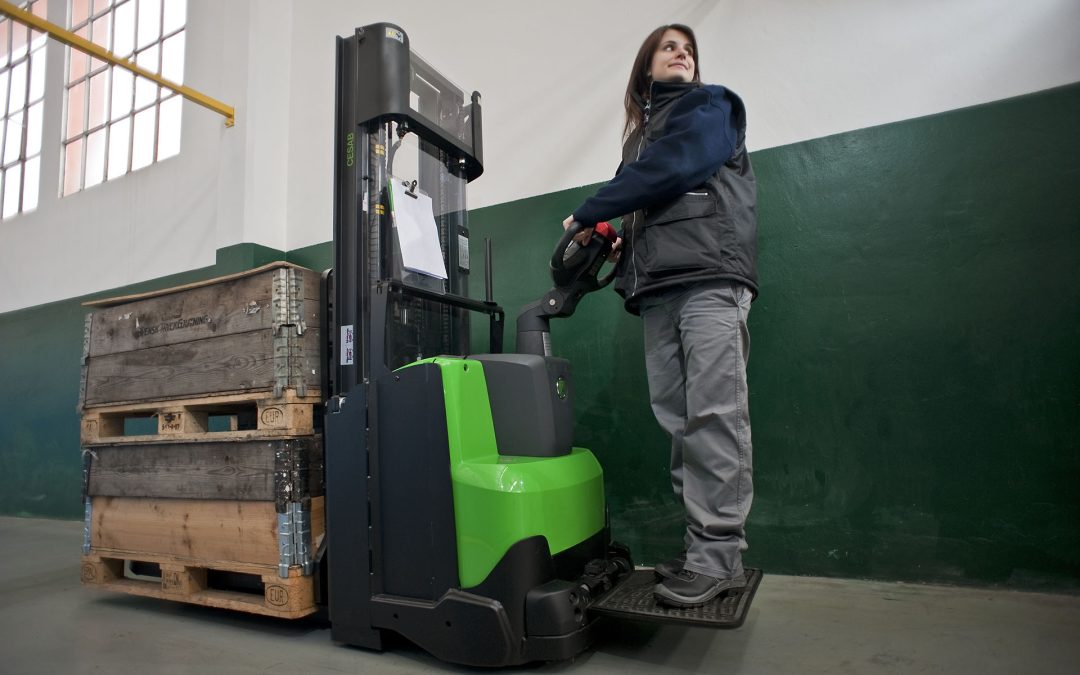Pedestrian forklifts, also often known as stacker trucks, are small and compact trucks suitable for use in small spaces. They’re versatile machines and, with low-intensity and high-intensity models available, they’re suitable for use in a range of industries. In this blog, we explain what pedestrian forklifts are and what benefits they can bring to your business.
What are pedestrian forklifts?
Stacker trucks are small, compact forklifts which are operated in a standing position rather than being sat on like regular counterbalance forklift trucks. Sometimes, like the CESAB S200 and S300 stacker trucks, they have a foldable driving platform on which the operator stands to make it easier to drive the truck across long distances. In other cases, as with the CESAB S100 stacker truck, the operator simply walks along behind the truck.
Since they have a much smaller size than regular forklifts, pedestrian stacker trucks are designed to handle relatively small loads. Depending on their size, the capacity of stacker trucks ranges from around 1,000kg to 2,000kg. For comparison, four-wheel counterbalance forklifts typically have a capacity of 3,600kg, and rough terrain forklifts often have a capacity of up to 16,000kg.
Pedestrian forklifts tend to have shorter lift heights than other forklifts. This can limit their use to a certain extent, but their small size and superior manoeuvrability make them ideal for small to medium warehouses. High-intensity models like the CESAB S320 have a maximum lift height of 4050mm, which is more than adequate for many warehouses.
What are the benefits of stacker trucks?
Stacker trucks tend to be more affordable than counterbalance forklifts because they’re smaller in size and less powerful. They’re an excellent starting point for businesses that want to reduce manual labour and streamline their operations but don’t have the budget or space for a counterbalance forklift truck. Since they’re usually battery-powered, they’re affordable and convenient to run.
Pedestrian forklifts have a huge benefit of being more nimble than counterbalance forklifts. They can turn around easily in confined spaces and narrow aisles. For cramped warehouses or stock rooms, they’re a far more versatile and sensible option than counterbalance forklifts. They also tend to be quieter since they run on batteries. The CESAB S100 stack truck has an exceptionally low noise level which makes it ideal for compact spaces or areas that are shared with office staff or customers and it’s important to maintain a quiet working environment.
Anybody who uses stacker trucks in your organisation ought to receive adequate training. However, since stacker trucks tend to be easier to operate than standard forklifts, the training process tends to be simpler and faster. This makes it a great machine for complete beginners to work with. Those who are already trained in counterbalance forklifts can easily pick up the skills necessary for operating pedestrian forklifts with minimal training. Plus, since the trucks have lower capacity loads than counterbalance forklifts, the risks associated with their use are reduced.
What industries are pedestrian forklifts useful for?
Pedestrian forklifts can handle a wide range of materials and are best suited to moving pallets over short distances. This makes them suitable for small to medium-sized warehouses, particularly where aisles are very narrow. They’re also great for retailers that have high shelves in stock rooms.
Many small-to-medium sized production facilities can benefit from using stacker trucks to manoeuvre materials around. The trucks cut down on manual labour and therefore speed up operations and reduce the risk of injury. They’re particularly useful for situations where space is confined due to the placement of manufacturing equipment because they’re nimble enough to manoeuvre through cramped areas.
Get in touch today and chat to our friendly team about how we can help with your forklift fleet.

 01282 842 678
01282 842 678